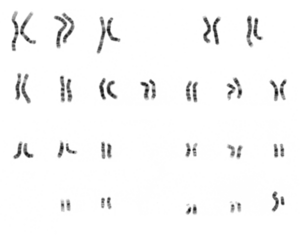Karyotype facts for kids
A karyotype is like a special picture of all the chromosomes inside a cell's nucleus. Think of it as an organized photo album of your chromosomes! It shows how many chromosomes there are and what they look like. Scientists use a microscope to see them up close.
They look at things like how long each chromosome is. They also check where the centromere (a special part of the chromosome) is located. Scientists also look for differences between sex chromosomes, which determine if someone is male or female. Studying karyotypes is part of a science called cytogenetics, which combines cytology (the study of cells) and genetics (the study of heredity).
The normal number of chromosomes in the body cells of an animal or plant is called the somatic number. This is shown as 2n. For example, humans have 46 chromosomes in their body cells, so for humans, 2n = 46.
In sex cells (like sperm or egg cells), the number of chromosomes is half. This is shown as n. So, for humans, n = 23.
Most normal living things are diploid. This means their body cells have two copies of each chromosome. Some cells can have more than two copies; these are called polyploid cells. Cells with only one copy of each chromosome are called haploid. The study of all the chromosomes together is sometimes called karyology.
What is a Karyogram?
A karyotype is often shown as a picture called a karyogram or idiogram. To make this picture, scientists take a photo of the chromosomes. Then, they arrange them in pairs, usually from biggest to smallest. They also line them up based on where their centromere is.
Karyograms are very useful! They can help doctors find out if someone has a genetic disease. They can also show the sex of an animal. In humans, doctors use karyotypes to check for genetic problems a baby might have even before it is born.
Scientists can also study karyotypes to learn about how living things have changed over time. This can show them past evolutionary events, like when an organism became polyploid.
Images for kids
See also
 In Spanish: Cariotipo para niños
In Spanish: Cariotipo para niños







